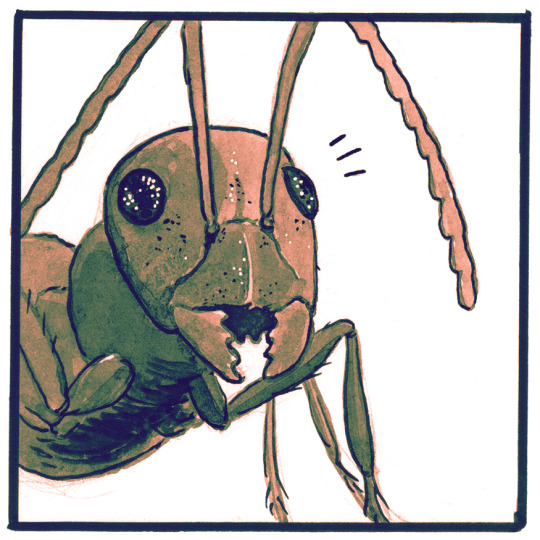Text

This guy always takes his chocolate art to the next level!!... Omg!!
(Source)
26K notes
·
View notes
Text
2K notes
·
View notes
Text
I think I’m going to think about this youtube comment forever

#honestly though a bit of vigilanteism#is the only way to survive middle school#that and the civic disobedience
67K notes
·
View notes
Text
would you put a discarded fruit sticker on my forehead in whimsical jest yes or no
159K notes
·
View notes
Text

Does this count as finding a walrus at your door?
53K notes
·
View notes
Text
No offense to Pasteur, but bacteriology is at least 10% easier when the scientific name tells you where to look for a bacteria.
#Especially when the nomenclature is like#epidermidis is on skin#equus is on a horse#bovis is on a cow's butt#pasturella is on pasteur's.... wait a minute
4 notes
·
View notes
Text
My cousin umpteen times removed named her kid Castiel. I genuinely don't know how that's working out for him, as he's gotta be nine or ten by now.
6K notes
·
View notes
Text
we've been living in this apartment for two months now, and while we've observed most of our new neighbours (my slavic Windowsill Watcher Grandmother gene already activated), I don't think they had the chance to see us often enough to recognise us yet.
I do know, however, from my observations, that the tiny funny dog upstairs is called Gucio. I've passed him once or twice during his walk and heard his owners use the name - and, while both the dog and his owners are oblivious to our existence, Gucio became an apt topic of discussion in our house. you know, we hear barking, ha, that's Gucio, he must be home alone again! or there's a stick left by the building door, that must have been brought by Gucio and he was forced to abandon it before entering! a household name, really.
yesterday as I was leaving to go to the store, walking down the narrow staircase, there he is! tiny funny looking dog, slightly startled by me suddenly appearing on the floor he just reached on his tiny funny looking legs.
"good morning Gucio!" I say joyfully, the most natural thing in the world.
well. remember that Gucio doesn't really know me. so he looks at me in the most flabbergasted way a dog can look at a person. he is positively aghast. agog! not sure how aware dogs are of their own names but he seemed genuinely puzzled at the apparent stretch of social convention.
and as I try to contain my laughter, I see his owner standing on the stairs below. the woman is sort of awkwardly frozen, speechless, and she looks at me.
"you... know each other?" she asks.
is that not the funniest way to phrase it. is this not the funniest question she could have asked. ma'am do you know my dog? you went to school together perhaps? you've met? do tell, are you old friends? maybe you worked together? you know each other, my dog and you? this dog? you know him? he knows you? he never mentioned you I'm afraid
20K notes
·
View notes
Text
Letters from Watson, the Engineer's Thumb
Crimes in Context: Counterfeiting, circa 1889
What coins were the Stark-Becher gang trying to make, anyway? And did they actually need a person squishing hydraulic press to do it?
Most of the cash in circulation in Victorian England would have been coins, so it's time to refresh our memories on what they all are, since I last addressed currency smaller than a pound in The Man with the Twisted Lip. We will be restricting ourselves to denominations that the Stark-Becher gang may have been minting, based on the comment that the hydraulic press was necessary to make coins that were previously minted in silver.
Imperial Currency Definitions
Pound/Quid/Sovereign: Not applicable, the Sovereign coin is gold, but it's the base unit of the currency we're dealing with. It also would have been hard to pass as genuine just because it's a large denomination - the era's equivalent of a hundred dollar bill. Indeed, our Bank of England inflation calculator returns a modern value of £107.
Crown: Five shillings / a quarter pound. Represented by a silver coin. Probably the largest coin you'd make change for without being annoyed by it.
Shilling: 1/20th of a pound. A silver coin.
Crowns and Shillings are our most likely candidates, as they're in common use in 1889 and is the kind of cash an average man might have on hand. I personally think shillings are the most likely coin to counterfeit, as a lot of accounting of people's wages, expenses, etc. in this time period is written as pounds / shillings / pennies (L/s/d) and silver pennies (And their horrible spawn of sixpence, twopence, etc) are probably not worth the effort. Also, while there were silver pennies in circulation, the fact that things like silver twopence were minted for maundy money makes the timeline and consistency of their minting beyond my pay grade as a blogger. And probably confusing for a coiner to get exactly right, given the payoff.
Hydraulic press:
Modern (paper*) money is printed with several aspects that make it harder to reproduce: the exact fiber content of the paper, the multi layered and detailed design (with parts that can only be seen under UV light, parts that can only be seen with a magnifying glass, etc.), the embossed parts of the print design, and the exact chemical components of the ink can be analyzed to see if a note is authentic. The ink in US dollars also contains a smattering of heavy metals that aren't great for human health, so I don't recommend consuming money in any way - don't lick it, don't snort things off it, don't put it in your blender for a science fair project. It would be chemically somewhat dangerous to counterfeit modern currency at home, assuming you got anywhere close to the right ink.
*Some countries use polymer, but same difference. It will kill your blender, though.
The Victorians did... none of that, really. The idea of designing money to be harder to fake was already around, but metal coins can only be produced to a certain degree of precision with the tools that were available in the 1800's: you essentially heat a disk of the correct metal (a blank) and press it with a stamp. The hydraulic press would, of course, squash blanks between two plates of stamps precisely, and with great force.
Both silver and gold have relatively low melting points (under 2,000 degrees F / close to 1,000 C) and are malleable at lower temperatures than the iron or steel of a hydraulic press. Silver amalgam (a silver/mercury alloy) has an even lower melting point, so it would be even easier to fit to a mold.
Essentially, anybody who knew much about molding metal and could get a precise-ish model of the coin in question would make pretty convincing money. A hydraulic press large enough to fit three grown men between the plates of may have been overkill.
18 notes
·
View notes
Text
Letters from Watson: The Engineer's Thumb
Part 3: The fun bits
Holmes' crime scrapbook immediately confirms that at least one other person has been murdered when the counterfeit operation has needed maitenance. I still wonder where the gang obtained the press (and how they got it installed) in the first place, as that's unlikely to be work they could get done in a single night.
Bradstreet's method for searching the countryside is actually a good idea - if the carriage ride hadn't been simulated. He believes that Hatherly was rescued by someone in the house, perhaps the woman or a servant. A possible other explanation is that he spent the walk back to the station in a fugue state that he doesn't remember.
Dr. Beecher (Stark's English partner) appears to have been known in town far more than Stark, very possibly he was normally in charge of keeping the operation secret and the household unremarkable, and Stark was in charge of other aspects.
4 notes
·
View notes
Text
someone just called the science museum to complain that this eclipse wasn’t as good as the one in 1979.
he wasn’t even a visitor, he was just mad about the eclipse not being visible without special glasses and wanted to complain to me about the eclipse “not being dark enough” for ten solid minutes
11K notes
·
View notes
Text
Letters from Watson: The Engineer's thumb
Part 2; The fun bits
A good part of the deduction in this case rests on this horse and carriage trick: between the inconsistency between Hatherly's calculations of about twelve miles, and Stark giving the distance as seven, we have the absolutely fresh horse. It must be clear quite early to Holmes that the carriage ride is a decoy, since Hatherly clearly got himself back to the train station despite his severe injury.
Hatherly notes the "absolute stillness" which he takes to mean that they're in the country. Not knowing much about the English countryside, I take it as a city boy not knowing that the sounds of nature at night can be fucking loud, and that the stillness he hears is a lack of the normal amount of people that would live in a country or small town house, because it's abandoned.
Based on the german-speaking woman's words, I am fairly certain that killing Hatherly was always the fall back plan. An orphaned bachelor with a failing consulting business would not be missed for potentially several days, at which point it could be extremely difficult to track him to Eyford. The carriage chicanery points to Stark and his partner initially planning to leave Hatherly alive, at least temporarily, but murder was always on the table.
The "chinchilla" beard is probably not a specific hair style, but just a tufty or scraggly beard.
The hydraulic press being built into a room, and the fact that neither Stark nor his partner thought of checking the gaskets, suggests to me that they likely had someone who knew more about presses involved in this forging operation when they started out. I wonder what happened to him?
4 notes
·
View notes
Text
Letters from Watson: The Engineer's Thumb
Part 1: The Fun Bits
Hatherly is "exceedingly pale" and Watson mentions agitation as a cause even though he's already noted the possibility for excessive blood loss, and that railway cases are "seldom trivial." Hooray for Victorian medicine.
Fun fact: if you're fainting from blood loss you already need a transfusion. As of '89 we are two decades before safe (relatively) blood transfusions, when the ABO clotting factors were discovered. However, given the pain and stress, the cause of Hatherly's fainting doesn't have to be hypovolemic shock. Hatherly did just lose a thumb.
A carbolised bandage would have been a bandage treated with phenol (carbolic acid) as a disinfectant. I would not recommend raiding Watson's stash for it, as carbolic acid can cause chemical burns.
I cannot decide if Holmes' habit of smoking all the leftovers of his previous day's pipes is gross or endearing.
In two years, Hatherly has earned 27 pounds and 10 shillings. (Using the trusty Bank of England inflation calculator, which does not DO fractions of a pound, this is just over 2,870 modern pounds, or $3590) He is not having a great start.
Reminder that a guinea is 1 pound, one shilling. 50 guineas is almost double the amount Hatherly has ever made in his entire practice. And yet the thing that actually makes him suspicious is that the consultation is scheduled for late at night, after the trains have stopped running.
Fuller's earth is a white, highly absorbent clay, used as a chemical filter and absorber. Actual mineral composition may vary, but the use it was named for was when wool processors (Fullers) would use it to clean oils and dirt from wool. This step would have been prior to spinning or felting the fiber.
A hydraulic press would be extremely unnecessary for shaping any kind of clay, since it's... clay. The first time I read this I confused Fuller's Earth with Diatomaceous earth, which is powdery in structure and therefore might need some kind of squishing to be formed into a brick.
I was unable to find any town or city named Eyford, so I'm assuming it's another slightly fictionalized location.
The horse trick here has always struck me as a clever insight on Holmes' part: of course, he is already aware that this is a scam of some kind, and that the secrecy measures would include a lot of misdirection
9 notes
·
View notes
Text
Letters from Watson: The Engineer's Thumb
Published: March 1892
Set: September 1889 (Baring Gould), any time summer of 1889 (me)
Aside from any quibbles I may have about whether the middle of September counts as summer culturally vs. "is technically mostly before the fall equinox" the date of this story is supported by canon, stating that this is the summer after Watson's marriage (also stating that it is '89.)
The real mystery of timing is why Watson states that he has only brought two of Holmes' cases to his notice, citing this one and "Colonel Warburton's Madness," which we will never hear more about. This is not necessarily accurate: previously published stories include The Naval Treaty (Phelps reached out to Watson first). It may be that he is only counting cases Watson was first contacted as a professional, rather than a friend, however.
A slight discrepancy is that Watson refers to as the "lapse of two years" between a 1889 case and a 1892 publication, but we of course don't know when he first wrote the case up.
10 notes
·
View notes





